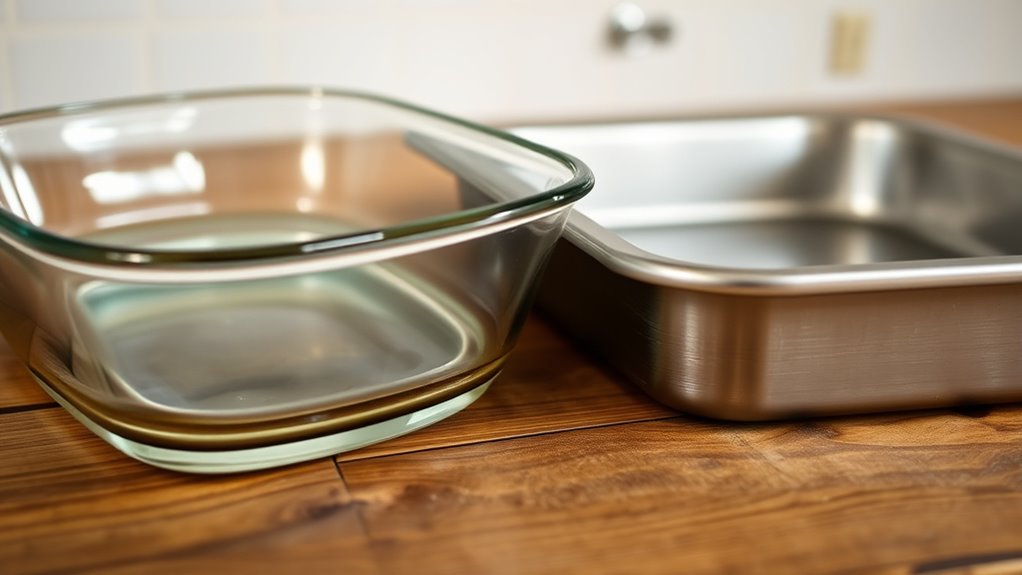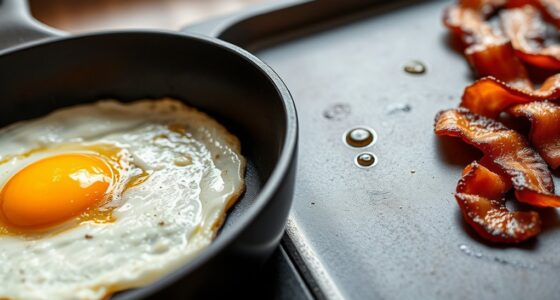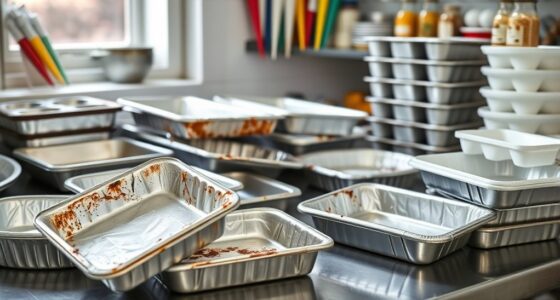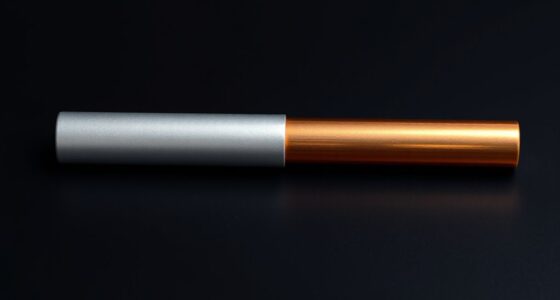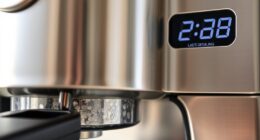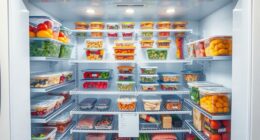When using glass versus metal bakeware, you’ll notice timing differences. Glass heats more slowly and evenly, so you might need to extend baking times slightly. Metal responds quickly, allowing for shorter, more precise adjustments but can develop hot spots, possibly requiring rotation. Understanding these differences helps you better control your results. If you’re curious about how to optimize your baking based on these materials, keep exploring for more useful tips.
Key Takeaways
- Glass heats slowly and evenly, often requiring longer baking times compared to metal.
- Metal heats rapidly, allowing for shorter, more precise baking durations.
- Uneven heat distribution in lower-quality metal can cause hot spots, affecting timing accuracy.
- Glass’s slow response to temperature changes necessitates careful monitoring and potential time adjustments.
- Metal’s quick responsiveness enables better control over baking time and temperature adjustments.
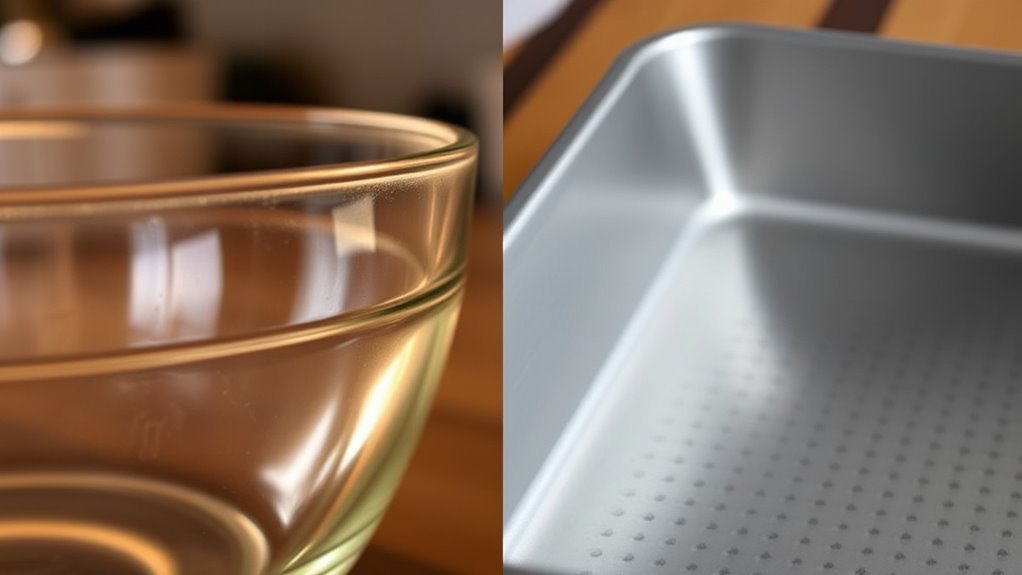
Choosing the right bakeware material can considerably impact your baking results and overall experience. When deciding between glass and metal bakeware, understanding how each material affects oven heat distribution and durability differences is key. These factors influence not only how evenly your baked goods cook but also how long your bakeware will last and perform over time.
Glass bakeware heats differently than metal. It tends to distribute heat more slowly and evenly across the surface, which can be beneficial for delicate baked items like casseroles or custards. Because glass absorbs and retains heat well, it often results in a more consistent baking temperature, reducing the risk of hot spots. However, this slower heat transfer means that you might need to adjust your baking times—often increasing them slightly—since the oven takes longer to reach the desired internal temperature of your dish. Keep in mind that glass bakeware is less responsive to temperature changes, so rapid adjustments in oven temperature won’t have as immediate an effect as they do with metal.
Metal bakeware, on the other hand, heats up quickly and responds rapidly to temperature adjustments. This responsiveness allows you to fine-tune your baking process easily. Metal’s excellent oven heat distribution means your baked items tend to cook faster and more evenly, especially if the metal is of high quality. Because metal conducts heat so efficiently, it’s often preferred for baked goods like cookies and cakes, where quick, even heat is essential for a good rise and proper browning. However, the higher thermal conductivity also means that metal bakeware can heat unevenly if not of good quality or if it’s poorly constructed, leading to hot spots that could cause uneven baking.
Durability differences also come into play when choosing between these materials. Metal bakeware generally offers greater durability; it’s less prone to breaking if dropped and can withstand higher oven temperatures. Aluminum or stainless steel pans can last for years with proper care. Glass bakeware, while sturdy in its own right, is more fragile. It can chip or shatter if dropped or exposed to sudden temperature changes, such as going from a hot oven to cold water. That said, glass bakeware is often more resistant to scratching and staining, making it easier to clean and maintain for many home bakers.
Additionally, advancements in non-stick coatings on metal bakeware have improved its performance and longevity, making it even more popular among bakers. Ultimately, your choice depends on what you’re baking and how you prefer to work in the kitchen. If you value quick response and durability, metal might be your best option. If even heat distribution and gentle cooking are more important, glass could be the way to go. Understanding these differences helps you tailor your bakeware selection to achieve better results every time.
Frequently Asked Questions
How Do I Adjust Cooking Times for Glass Bakeware?
When using glass bakeware, you should reduce your baking time by about 25% because it heats more evenly and retains heat longer. Also, lower the oven temperature by 25°F to prevent over-baking or burning. Keep a close eye on your dish, especially near the end of the original baking time, and check for doneness early. Adjusting your baking time and temperature guarantees your dish turns out perfect.
Does Metal Bakeware Require Preheating Differently Than Glass?
Did you know metal bakeware heats up 20% faster than glass? Metal requires preheating differently because of its superior heat conductivity, which means it rapidly transfers heat to your food. This quick heat transfer causes material expansion more quickly, so preheat your metal pans thoroughly before baking to avoid uneven cooking. Glass, on the other hand, heats more slowly and evenly, needing less preheating time.
Are There Specific Recipes Better Suited for Glass or Metal?
You’ll find certain recipes are better suited for glass or metal bakeware because of recipe compatibility and ingredient interactions. For example, glass is ideal for casseroles and baked desserts that require even heat distribution, while metal excels with quick-cooking baked goods like cookies and muffins. You should choose based on how the bakeware interacts with ingredients and the desired outcome, ensuring *best* baking results.
How Does Bakeware Color Affect Baking Time?
Your bakeware color considerably affects baking time because it influences heat absorption. Dark-colored bakeware absorbs more heat, leading to faster baking and browning, so you should reduce baking time slightly. Light-colored or glass bakeware reflects heat, causing a slower bake. Adjust your timing accordingly, keeping an eye on your baked goods to prevent over- or under-baking. Always monitor your items and make small adjustments as needed.
Can I Use the Same Temperature Settings for Both Materials?
Think of your oven as a stage, and your bakeware as the performers. You can’t use the same temperature settings for both because of their different material expansion and heat conduction properties. Metal heats quickly and conducts heat evenly, so you might need a slightly lower temperature. Glass heats more slowly and retains heat longer, so keep the original temperature but watch your baking times closely. Adjust accordingly for perfect results.
Conclusion
Choosing between glass and metal bakeware is like selecting the right gear for a race—you want the one that matches your pace. Glass heats evenly and needs a longer bake time, while metal heats up fast for quicker results. By understanding these timing differences, you can confidently navigate your baking journey, ensuring your treats come out perfect every time. So, pick your gear wisely and let your baking adventure run smoothly!
